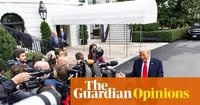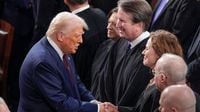In a dramatic turn of events that could reshape the balance of power between the White House and the nation’s central bank, President Donald Trump’s attempt to remove Federal Reserve Governor Lisa Cook has landed at the steps of the U.S. Supreme Court. The legal battle, which began in late August 2025 when Cook filed suit against what she called an “unprecedented and illegal” firing, now stands poised to set a precedent for presidential authority over the historically independent Federal Reserve Board.
On September 9, 2025, U.S. District Judge Jia Cobb issued a preliminary order that kept Cook on the Federal Reserve Board as her lawsuit against Trump’s removal efforts moved forward. According to NBC News, Judge Cobb reasoned that Cook would likely succeed in her litigation, noting the administration “does not dispute that it failed to provide Cook even minimal process — that is, notice of the allegation against her and a meaningful opportunity to respond — before she was purportedly removed.”
The Trump administration, undeterred, filed an application on September 18, 2025, asking the Supreme Court to lift Judge Cobb’s order. This urgent request comes on the heels of a divided federal appeals court panel’s decision just days earlier, which declined to overturn Cobb’s ruling. The panel’s majority, consisting of Judges Michelle Childs and Bradley Garcia—both Biden appointees—focused on due process concerns, while Trump appointee Gregory Katsas dissented, arguing that Cobb erred in finding that Cook had a constitutionally protected property interest in her office and could not be removed based on alleged conduct prior to her appointment.
The stakes are exceptionally high. As Newsday reports, this is the first purported “for cause” removal of a Federal Reserve Board Governor in the institution’s 111-year history. The Federal Reserve Act stipulates that board members can only be removed “for cause,” a safeguard designed to insulate the central bank from the political whims of any single administration. Cook’s term, notably, does not expire until 2038, underscoring the long-term implications of the case.
President Trump’s rationale for firing Cook centers on allegations of mortgage fraud supposedly committed before her Senate confirmation. However, recent reporting suggests these claims may be unsubstantiated, and Cook has not faced any criminal charges. Yet, as NBC News points out, the legal question before the Supreme Court may not hinge on the truth of the allegations. If the Court determines that judges cannot examine the president’s motives—echoing its stance in upholding Trump’s travel ban during his first term—then the president’s mere assertion of “cause” could suffice, regardless of the facts.
Cook, in her civil complaint, emphasized the broader consequences at play: “Fed independence is vital to its ability to make sound economic decisions, free from the political pressures of an election cycle. If markets and the public believe that the central bank is making decisions based on political pressure rather than sound economic data, that confidence erodes.” Her warning resonates amid Trump’s ongoing campaign to pressure the Fed into lowering interest rates, a strategy that saw some success when the central bank cut rates last Wednesday—though not as steeply as new Trump-appointed board member Stephen Miran advocated. Miran, confirmed by the Republican-led Senate on September 15, 2025, has already signaled his alignment with Trump’s vision for the Fed, further highlighting the administration’s efforts to reshape the board.
This dispute is unfolding against a backdrop of unprecedented legal maneuvering by the Trump administration. According to Newsday, Trump’s legal team has filed nearly two dozen emergency requests to the Supreme Court via the so-called “shadow docket” or “emergency docket” system since his return to office. This approach allows for rapid, often temporary rulings without the lengthy process of oral arguments and written opinions. Over the past nine months, the Supreme Court—now comprising six conservative justices, including three Trump appointees—has overturned lower court decisions in favor of Trump’s policies more than a dozen times, enabling the administration to proceed with aggressive immigration tactics and a sweeping overhaul of the federal workforce.
Legal scholars are sounding the alarm about the implications of this strategy. James Sample, a constitutional law professor at Hofstra Law School, told Newsday, “It is as fundamental to our system of judicial process as can be that when the court decides a matter, especially a matter of significant importance, it needs to explain its reasoning. And what has been happening is that the Supreme Court has been issuing these decisions of massive consequence with minimal and in some cases, no explanation.”
The numbers are striking. Since Trump’s return to office, 28 federal court rulings have gone against his administration, with only nine in its favor, according to Lawfare. In response, the administration has filed 23 emergency requests with the Supreme Court, which has sided with Trump in 17 of those cases, according to SCOTUSblog. These emergency orders have had far-reaching effects, from allowing immigration enforcement based on racial appearance and pausing deportations to South Sudan, to permitting the Pentagon to enforce a ban on transgender service members and enabling widespread federal layoffs.
White House officials, for their part, defend the strategy as necessary to counter what they describe as judicial overreach. “There is a troubling and dangerous trend of unelected judges inserting themselves into the presidential decision-making process,” White House Press Secretary Karoline Leavitt said during a May 29, 2025, briefing, as reported by Newsday. The administration contends that lower courts are improperly blocking major initiatives, including the firing of federal workers and the freezing of billions in foreign aid.
Yet, the lack of written explanations in many Supreme Court emergency rulings has created confusion and concern among legal experts and lower court judges. Jenny Breen, an associate professor at Syracuse University College of Law, told Newsday, “What we’re seeing in the shadow docket cases is literally no reasons given or the best case scenario, two sentences of reasons given, and this is completely contrary to the work of the courts and what the Supreme Court should be doing.”
As the Supreme Court prepares to weigh in on Trump’s authority to remove Federal Reserve Board members, the outcome could redefine the limits of presidential power and the independence of one of the nation’s most crucial economic institutions. The decision, whenever it comes, will reverberate through the financial markets, the federal government, and the broader American public—potentially for years to come.


